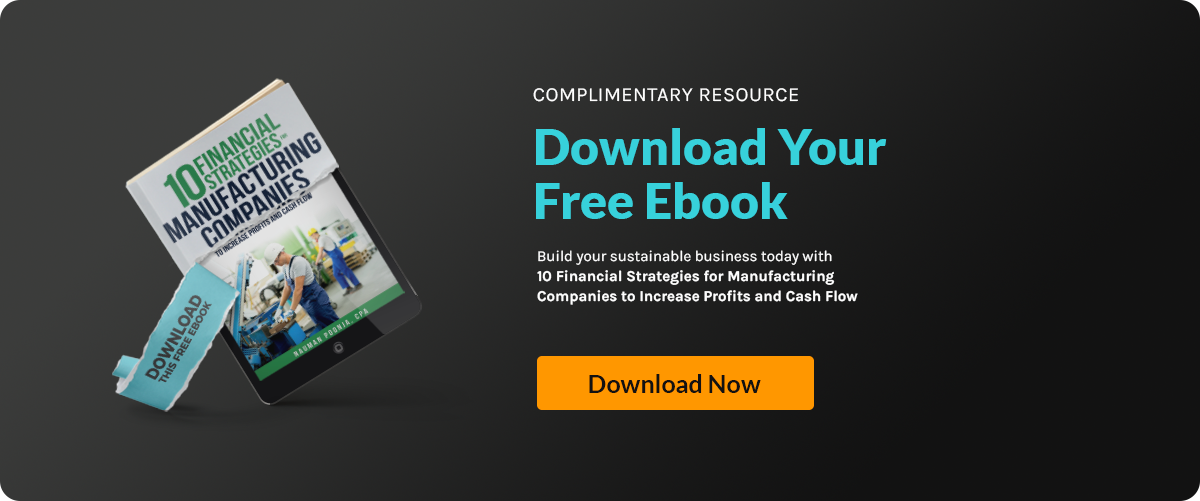In an era where efficiency and productivity are top priorities in manufacturing, KPIs must be...
Tax Credits for Manufacturing Companies: R&D and Domestic Manufacturing Incentives

Running a manufacturing business often means tight margins and heavy investment in equipment, materials and labor. Tax incentives can lighten that load. Two of the most powerful incentives in the United States are the Research and Development (R&D) Tax Credit and a range of domestic manufacturing credits designed to encourage on‑shore production. Understanding how these programs work and planning ahead can help you increase cash flow, fund innovation and stay competitive. This guide breaks down the key elements of these credits and shows how to integrate them into your financial strategy.
What Is the R&D Tax Credit?
The R&D Tax Credit is a federal incentive that rewards companies for investing in innovation. It’s available to manufacturers of all sizes that develop or improve products, processes or software. To qualify, activities must:
- Have a permitted purpose. Work must aim to create new or improved products, processes, techniques or software.
- Be technological in nature. Projects must rely on principles of physical or biological science, engineering or computer science.
- Address technical uncertainty. The company must face challenges about whether it can develop the desired result or how to achieve it.
- Involve a process of experimentation. There must be systematic testing or evaluation of alternatives.
Qualifying expenses often include wages for engineers and technicians, supplies used in prototypes, and a portion of contract research expenses. Many states also offer their own R&D credits, which can be claimed alongside the federal credit.
How R&D Credits Benefit Manufacturers
At its core, the credit reduces your tax bill. Instead of expensing research costs and hoping for future returns, you get a direct credit against income taxes. For small businesses, part of the credit may even offset payroll taxes, freeing up cash to reinvest in growth. The savings can be substantial, especially for manufacturers whose innovation cycles are continuous.
By reducing the after‑tax cost of experimentation, the credit encourages companies to take on projects that might otherwise be shelved. This leads to better products, more efficient processes and stronger margins. When combined with profitability strategies such as rigorous cost tracking and product‑mix analysis, R&D credits can transform innovation from a cost center into a profit driver. The tax savings free up funds for hiring additional engineers, upgrading equipment or investing in automation.
Documenting and Claiming the R&D Credit
Claiming the credit requires thorough documentation. You’ll need to demonstrate that projects meet the four‑part test and that expenses are properly allocated. Best practices include:
- Maintaining project lists: Create a log of all R&D projects with descriptions, objectives and timelines.
- Tracking time and wages: Capture engineers’ hours on a per‑project basis. Integrated accounting systems make this much easier; they tie payroll data directly to project codes and are part of many manufacturers’ GAAP‑based accounting best practices.
- Collecting supporting evidence: Keep meeting notes, test results, prototypes and design iterations to show the process of experimentation.
- Working with a specialist: Tax rules change frequently. Partnering with a CPA experienced in R&D credits ensures that you maximize your claim and comply with current regulations.
Automated systems can streamline the process. By digitizing timekeeping, expense tracking and document storage, you reduce the risk of missing eligible costs and improve accuracy. This is where accounting automation pays dividends—manual spreadsheets are prone to errors and make it difficult to capture nuanced research activities.
Domestic Manufacturing and Advanced Manufacturing Credits
The U.S. tax code includes incentives aimed at bolstering domestic production. While the old domestic production activities deduction (Section 199) was repealed in 2017, new credits have emerged to encourage on‑shore manufacturing in strategic industries.
One example is the Advanced Manufacturing Production Credit, introduced to support the production of renewable‑energy components, semiconductors and other critical goods. The credit is based on a percentage of the value of eligible components produced in the United States. For manufacturers in these sectors, it can offset significant portions of tax liability and improve project economics. Eligibility depends on the type of product, compliance with wage and apprenticeship requirements and adherence to domestic‑content rules.
Even if you don’t qualify for the advanced manufacturing credit, other incentives may apply. Many states offer domestic‑manufacturing credits or deductions for investments in facilities, equipment and workforce training. When evaluating expansion or modernization, factor these incentives into your capital planning. Aligning them with labor cost control efforts can yield an even greater return on investment.
Combining Credits and Planning Ahead
Tax incentives rarely operate in isolation. You can often claim both federal R&D credits and state‑level manufacturing credits as long as you avoid double‑counting the same expenses. Strategic planning is key:
- Coordinate with capital planning. If you’re investing in new machinery or a facility, research available incentives ahead of time. Some credits require pre‑approval or binding agreements before construction begins.
- Integrate with cost forecasting. Incorporate expected tax savings into your financial models. Tools like cost–volume–profit analysis help you see how credits impact break‑even points and margins.
- Monitor cash flow. Credits are typically claimed on the tax return, so there may be a lag between when expenses occur and when benefits are realized. Maintain strong financial risk management practices to bridge the gap.
Review payroll and workforce strategies. Because R&D credits are wage‑driven, investing in skilled labor and training can boost your claim while improving productivity. Combining credits with programs that improve labor cost control can amplify the impact.
Final Thoughts: Make Tax Incentives Part of Your Growth Strategy
R&D and domestic manufacturing credits offer powerful tools for manufacturers seeking to innovate, expand and compete. They lower the cost of experimentation, encourage domestic investment and free up cash for strategic initiatives. To maximize the benefits, integrate tax planning with your broader financial strategy. Use automated systems to track qualifying activities, apply profitability strategies to measure the impact and incorporate incentives into your long‑term forecasting.
By staying proactive and informed, you can turn tax credits from a once‑a‑year exercise into a continuous engine for growth. As always, work closely with your financial advisors to ensure compliance and to tailor a plan that fits your specific business needs.







